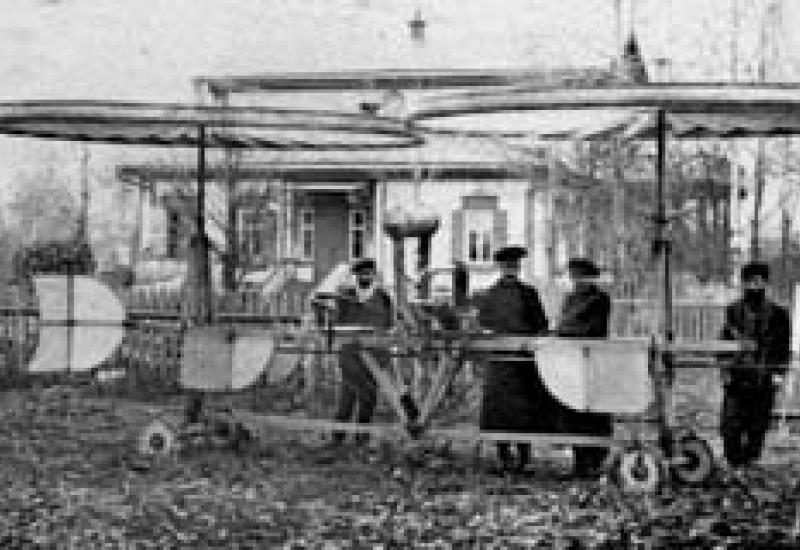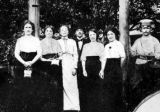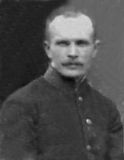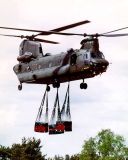This spring, fate leaded us to graduator of KPI Valery Ivanovich Dzyubak. Many years ago Dzyubak family lived in a house with Natalia Sorokina in Pechersk. It was a lonely older woman, she came to Kyiv from Novgorod-Seversky after the revolution of 1917 and got to work Kyiv CID. After N.I.Sorokina's death, her personal belongings were left, including an old photo album, the student KPI - Valery paid attention on it: young boy interested in bizarre helicopter that was in one of the photos.
After the KPI graduation, V.I.Dzyubak worked in Central Design Bureau of the plant "Arsenal", engaged in assembly and test space training system. His work has been associated with constant travel, during which V.I.Dzyubak visited many museums of aviation, but there he didnt find even a mention of helicopter of similar construction.
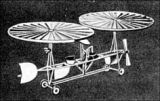 As a result of thorough research photos from an album we were able to discover a lost page in the history of aviation. It is our further narrative.
As a result of thorough research photos from an album we were able to discover a lost page in the history of aviation. It is our further narrative.
At the beginning of the 20th century, many countries in the world began to work with construction of helicopter. In that time the first samples of helicopters of different schemes were emerged: one screw; two coaxial screw, transverse and longitudinal; many screw. The first were the French: brothers Jacques and Louis Breguet (Louis Breguet, Jacques Breguet), Professor Charles Richet (Charles Richet) and Paul Cornu (Paul Cornu). 24 August 1907 helicopter that was built by the brothers Jacques and Louis Breguet under the direction of Charles Richet, off the ground and stayed in the air at a height of about 50 cm per minute. The first man who rose into the air on helehopter was Paul Cornu. November 13, 1907 helicopter built by P.Kornyu longitudinal scheme rose vertically into the air to a height of 50 cm. The unit stayed in the air 20 seconds. These two events marked the beginning of the era of practical construction of helicopters.
There also were enthusiasts of this concern in the Russian Empire, part of which then was Ukraine divided into provinces. V.Tatarinov, K.Antonov, M.Sorokin, V.Levytskyy, S.Oschevski-Kruglik and others built helicopter with internal combustion engines.
I.Sikorsky built his first helicopter too. Lifting capacity of his first helicopter, which was drawn up in 1909, was not sufficient for the flight. After building a helicopter he went to Paris, where he met with Charles Richet and Paul Cornu. Be rightly informed, I.Sikorsky built in 1910 a second helicopter that was able to get off the ground, but without a pilot on board. The fact that the construction of helicopters then was at an early stage and there had been a lot of unresolved issues, but rather a desire to rise into the air in self-built apparatus inspired I.Sikorsky to development of helicopter, although remarkable achievements other designers had already been obtained. I.Sikorsky returned to construction of helicopter only in 1938 to kept his airline from bankruptcy.
In 1909 in Moscow, student of Technical College - B.Yuryev under the direction of M.Zhukovsky began development of the helicopter theory. Unlike empirical search of other authors and inventors, foundation works of B. Yuryev were systemic and deep research that allowed him in 1912 to build a prototype helicopter, where he used his invention - machine-skewed.
But back to the old album. The photographs in album allegedly reflected very important technical development of a member of Sorokin family, such as Natalia's brother - Nicholas. Besides the quaint aircraft and its individual components, photographs preserved images of people involved in this event.
It was found that the aircraft from an old album - a helicopter with two holding screws located on longitudinal diagram and front pulling propeller.
In literature you can find only picture and some information about the machine and its inventor. Specifically, the main screws consisted of a large number of flat blades covered with cloth and were girded rim. Engine "Argus" 50 hp worked on all three screws.
Through photos from an album, the size of the machine and its components can be measured by comparative measurement method. The design of the mashine resembles a helicopter of P.Kornyu that had two six-meter rotors, nose rotor and tail rotor that are turned in opposite directions.
In 1909, M.Sorokin began build helicopter on the Russian Baltic Carload Factory (RBCF) in St. Petersburg. In 1910 on the RBCF, the creation of helicopters was discontinued: the plant was profiled to produce airplanes. In 1912, I.Sikorsky was invited on the RBCF, he headed the aviation department.
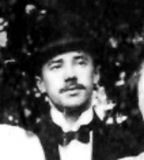 Photos from the album give us the opportunity to argue that although the creation of helicopters on RBCF was suspended, M.Sorokin continued to improve the design of helicopter in Novgorod-Seversky. He created helicopter in newly built manor on the bank of the Desna involving both professionals and handymen. This is also reflected in the photographs of the album.
Photos from the album give us the opportunity to argue that although the creation of helicopters on RBCF was suspended, M.Sorokin continued to improve the design of helicopter in Novgorod-Seversky. He created helicopter in newly built manor on the bank of the Desna involving both professionals and handymen. This is also reflected in the photographs of the album.
Helicopter of M.Sorokin caused great interest of many of his later famous contemporaries. I.Sikorsky visited Novgorod-Seversky too, we found his photo in the album. B.Yuryev made payments scheme of M.Sorokin helicopter. Taking the diameter holding and engine power, he calculated lift screws. Then, based on the ideas of the time, B.Yuryev calculated the strength of the design helicopter, blades, trusses, transmission, fasteners screws to the fuselage - and as a result had identified total weight of the machine. The resulting value of the total weight of the truss and the transmission was so great that B.Yuryev concluded: "... Build a helicopter type drawing" a " (drawings helicopter M.Sorokina - Ed.) Now it is impossible. ". Later, in 1911 B.Yuryev still engaged in designing and screw Twin-screw coaxial helicopters scheme.
Three amateur photos from this album helped identify the development of helicopter, on photos were depicted the opening of the monument to Emperor Alexander II in Novgorod-Seversky. It was in 1911.
M.Sorokin's persistence in building of helicopters, lack of information about his invention and the fact, that his sister took care of photo essay about the work of her brother, indicate that M.Sorokin probably died in those difficult years.
At the end of the narrative, we must say that twin-screw tandem configuration of helicopter was implemented only in 1945 in the US by Frank Piasecki. Piasecki helicopter called the "flying banana". He also called "flying car" because the design of the helicopter is resistant to moving the center of mass and allows for placing luggage almost the entire fuselage.
All illustrations, except photographs depicting helicopters of M.Sorokin and P.Kornyu, were published for the first time - the authors had taken them from the album of N.I.Sorokina.
http://www.minihelicopter.net/CH47Chinook/index.htm - Vertolit CH-47 Chinook used in 1966 to transport cargo, soldiers (33-44) weapons during the day and night.
Nov 29, 2007 || By L.R.Slobodyan, a leading researcher, L.A.Kovalenko, L.S.Perelyhina, V.V.Yankovuy senior researchers at DPM "KPI"

